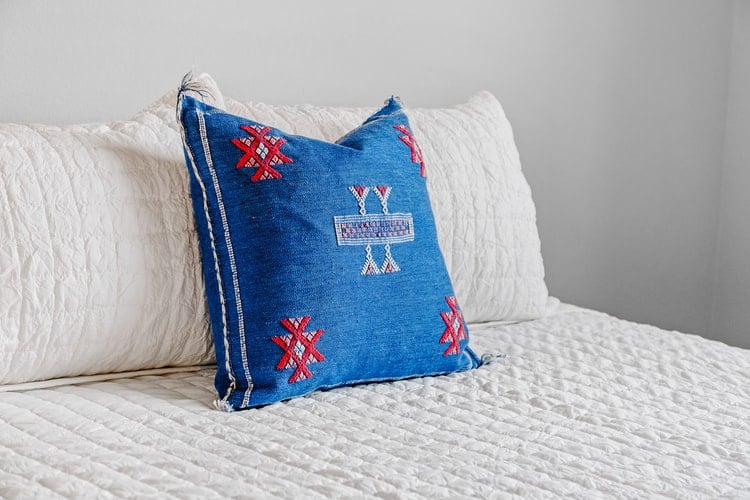More and more people are learning how to sew a cross-stitch pillow nowadays. These pillows are ideal projects for home décor enthusiasts.
From embroidered pillowcases to those with modern designs, many more people have attempted this trend. There are various geometric or floral prints, even ready-made sets showing landscape or themes. Cross-stitch pillows have you covered.

The Roots of Cross-stitching
Did you know that cross-stitch, as well as needlework, have dates as far back as the 6th century BC? According to historical findings, needlework has already been in existence since cloth was invented. In fact, archeological findings of ancient Egyptian tombs and Medieval churches across the globe have pieces of embroidery, as well as needlework in them.
Cross-stitching was such a hit in China during the Tang Dynasty that its popularity spread toward the west between 618 to 907 AD. This art has been embedded into their culture that they tied a woman’s worth to her stitching prowess.
Blackwork, which was believed to be the roots of cross-stitching in England, was introduced to the continent in the 16th century by Catherine of Aragon, the daughter of Ferdinand of Spain and Isabella. In case you’re curious, blackwork involves the use of black sheep wool on a piece of white linen cloth. To this day, countless people are still into blackwork.
The art of cross-stitching, as we know it today, was believed to have started in the 1960s by women who were looking for something to keep them preoccupied during their leisure time.
A Step-By-Step Guide on How to Sew a Cross-stitch Pillow
Cross-stitching pillows may sound like an elaborate task. Expectedly, this endeavor would take a lot of time, effort, and concentration. Regardless of the challenge, many people are becoming interested in this activity.
Wouldn’t it be great if you could create a simple work of art to complement the interior of your living area? And the best part is, you need not splurge on this home décor. Simply follow the steps outlined below to achieve the perfect look for your cross-stitch pillow.
Step 1: Prepare the necessary materials
Prepare all the materials before starting the task. Have your finished cross stitch design ready. The preferred fabrics are aida cloth, linen, or evenweave (cotton). An ideal choice is a 10-count farmhouse due to its bigger cloth that yields more significant results.
Additionally, you need cotton fabric or try out denim, twill, corduroy, or any woven type. Avoid using the knit fabric type or the stretchy material since it would be difficult to attach it to your aida cloth.
Step 2: Choose the type of fabric you want and trim down your stitch piece
Decide which fabric you want for your pillowcase. You can use a mix-up of prints on the front and back or go for a solid type. Cut your aida cloth (the one with the cross stitch on it) to your preferred size.
How do you trim down your stitch piece? Simply count the squares on all sides of the design. A typical square count would be around 6 or 7 stitches. Give an extra ½ inch as your seam allowance on each side.
Draw a line on your aida cloth using your friction pen to guarantee an even look all the way around the pattern. Don’t worry because the line will go away with heat later in the process. Next, cut along the lines that you drew.
Step 3: Make the pattern pieces
The next step would be to make the pattern pieces. You can make them first using paper, be cut out later, and traced directly onto the fabric. Or you can draw the pattern directly on the fabric.
For your side borders, cut two 4-inch strips. Do the same thing for your top and bottom borders. Set these pieces aside. To save time in cutting them, put two fabric layers together and cut through both those layers simultaneously.
For the back pieces, cut a 22-inch-wide piece. Fold it in two evenly and cut it in the fold area. This will make the 2 pieces of backing for your envelope back. After this step, you can now start assembling your pillow.
Step 4: Add the sides
Now, you need to add the sides. Trim the side pieces further, depending on the size of your stitch piece. Place the right sides facing together and keep the fabrics in place. Use wonder clips instead of pins so as not to destroy the aida cloth.
Sew a half-inch seam on the side. Have a wider border fabric, especially if you make use of a sewing machine. The aida cloth should be at the bottom. Do the same procedure for the left border.
Step 5: Lock in your stitches
Steam the seams on both border fabrics to lock in your stitches. Then finger press this part open on a flat surface and place the iron on the edge. Repeat steps 4 and 5 for the top and bottom borders.
Step 6: Layer the pillow top with the pillow back
After trimming the excess fabric, you now have a pillow top. Layer this with the pillow back. Do a ¼ inch seam around the edges using a zigzag stitch. Turn the pillowcase with the right side facing out, then insert your pillow. Hand-stitch the opening to close it.
Final Thoughts
With all the fashionable pillow patterns out in the market, it would be a refreshing idea if you learn how to sew a cross-stitch pillow for yourself. It’s a more innovative way to use your imagination. What’s more, it allows you to home decorate the hands-on way.
